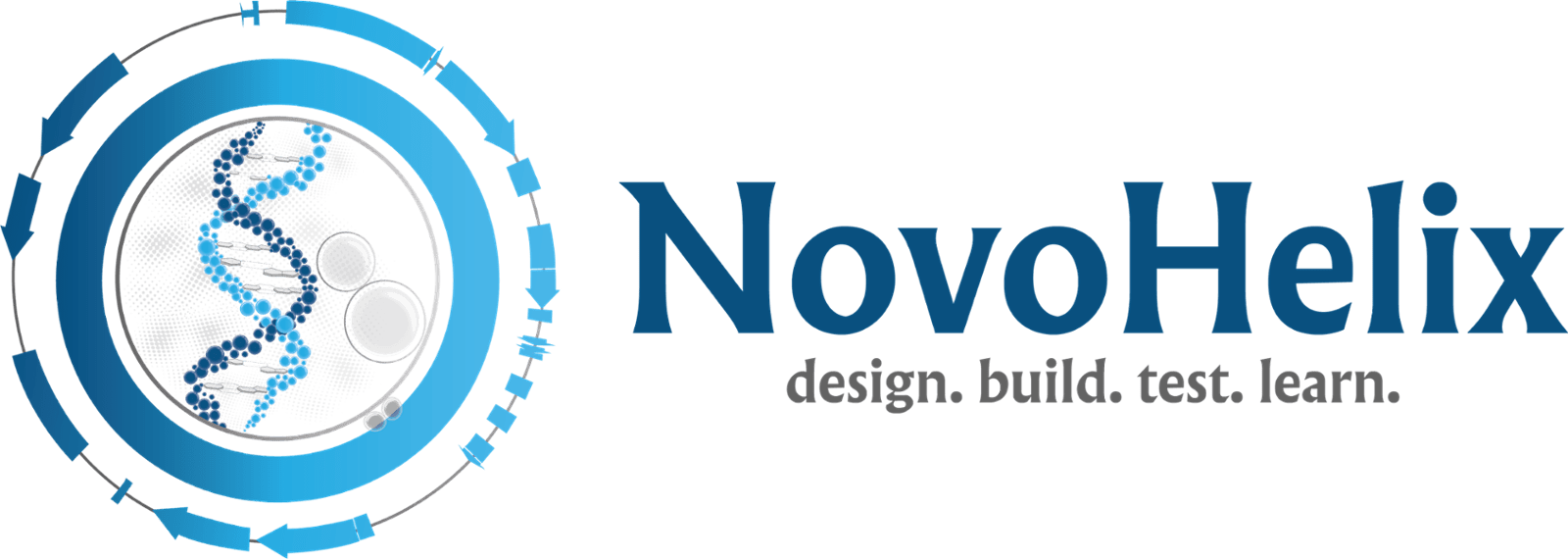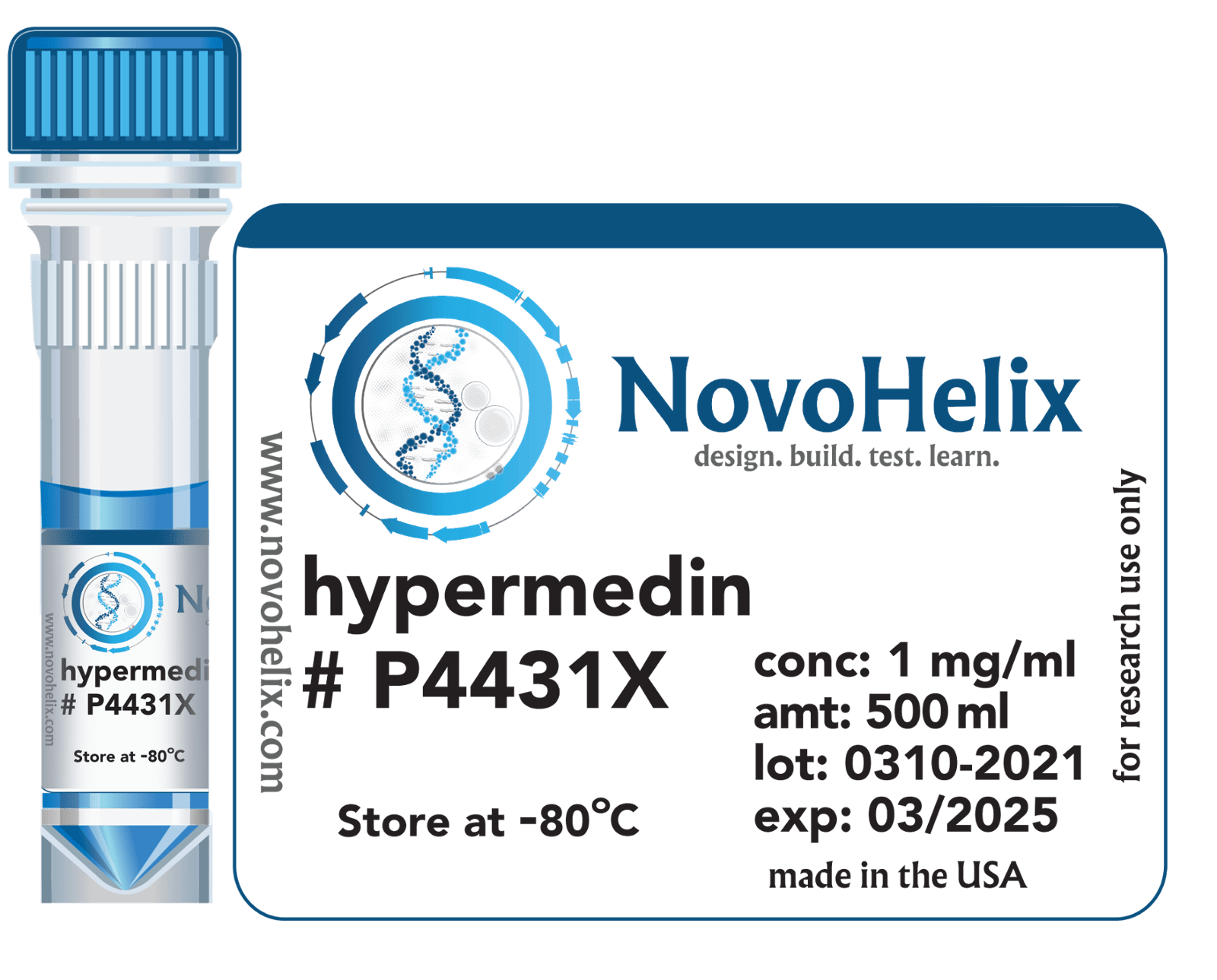hypermedin™ ― biosuperior human IGF1
The current trend of human pluripotent stem cell (hPSC) culture systems is to replace animal-derived materials such as FBS, BSA and supportive matrices such a Matrigel/Geltrex, a mouse-derived extracellular matrix, with defined factors in the media. At NovoHelix, our products are manufactured in the USA using chemically-defined components and, therefore, do not contain manufacturing components such as serum or animal-derived raw materials. Animal-derived materials are complex undefined mixtures and are recognized as significant risks for stable cultivation and clinical application since they have lot-to-lot variations and risk of immunogenic contamination. In addition, the undefined nature of these raw animal products makes it difficult to deconvolute the essential factors that drive growth, maintenance and differentiation programs.
Basic experimentation in early human development is hampered by the paucity of fetal material available to study typical developmental trajectories, by ethical issues associated with using human fetal tissues, and by a dearth of knowledge of the genetic and molecular programs that direct human embryogenesis and gametogenesis. Therefore, cellular models are a critical resource to understand dysgenesis and to advance our understanding of human infertility. NovoHelix’ approach to personalized medicine is to develop autologous cell models via epigenetic reprogramming of a patient’s own biopsied cells to pluripotency to create induced pluripotent stem cells (iPSCs). A refined reprogramming procedure using Sendai-viral RNA and pioneer factors such as OCT4/SOX2/KLF4 generates iPSCs akin to human embryonic stem cells (collectively known as hPSCs). When these hPSCs are bathed in media containing the appropriate supportive cues to differentiate into somatic and germ cell lineages, these cell-specific models yield enormous potential to better understand the mechanisms of cell specification. NovoHelix has manufactured a line of xeno-free cell reagents to support the establishment of clinical-grade human PSCs and to recapitulate some of the dynamic media environments necessary to elucidate key factors to boost our understanding of human development.
Product
Catalog Nr
Size
Concentration
Pricing
hypermedin™
P4431B
bulk
Want to try this product? Request a sample of hypermedin™ .
Product Information
Product Literature & Protocol
FAQs & Troubleshooting
References
Supporting Documents
Product Information
Advantages & Features:
- Hypermedin™ is a biosuperior recombinant human somatomedin C that is more potent than wildtype IGF-I or LR3-IGF1
- Hypermedin™ supplementation supports human pluripotency
- Aids derivation of new ES cell lines from epiblasts of human blastocysts
- Hypermedin™ is manufactured xenogen-free for establishment of chemically-defined media that supports human pluripotent stem cells (hPSCs)
- IGF1/insulin signaling via AKT/mTOR may obviate exogenous FGF2 supplementation in hPSC media
Source:
Human IGF1 was improved through protein engineering efforts including directed evolution and rational design. The final engineered protein was synthesized as a codon-optimized minigene and expressed heterologously in an E. coli strain. The recombinant protein was tested and normalized to standard activity assays for growth of human pluripotent stem cells.
Molecular Weight:
9110.6 ± 2 Daltons
Purity:
>96 % by SDS-PAGE and PMF + MS/MS
Sequence Analysis:
Purified recombinant protein was subjected to peptide mass fingerprinting (PMF) by MALDI-TOF/TOF (PMF + MS/MS).
Biological Activity:
Proliferation of a human pluripotent stem cell (hPSC) line cultured under 5% oxygen tension on a recombinant laminin 521 matrix with a serum-free DMEM/F12 standard basal media containing FGF2, TGFβ, Activin A, transferrin, vitamin C (L-ascorbic acid-2-phosphate), HRG1β (heregulin-1β), recombinant 0.1% HSA and supplemented with hypermedin™ (ED50 < 20 ng/ml). The hPSC line contains OCT4-P2A-tdTomato knock-in at the human POU5F1 locus to indicate which colonies are still pluripotent.
Endotoxin:
Lipopolysaccharide (LPS) was determined by the standard LAL (Limulus amebocyte lysate) test to be < 1 EU/µg. Due to potential environmental sustainability concerns (collection of the hemolymph used in pharmaceutical testing may negatively affect horseshoe crab populations), a quantitative and more sensitive endotoxin assay was developed using a pyrogen‐testing cell model with knock-in of TLR4/CD14/MD2 at the safe harbor locus AAVS. The TLR4/CD14/MD2 assay is used as an orthogonal screen for LPS in lieu of the LAL method and has a detection limit of 0.005 EU/ml.
Appearance:
A sterile, aqueous, clear and colorless solution.
Storage/Stability:
hypermedin™ is supplied at 1 mg/ml in stabilization buffer and remains bioactive for 30 days if maintained refrigerated [2º to 8ºC (35º to 46ºF)]. Stock solutions of hypermedin™ can be stored at least 3 months at -20°C and at least 6 months at -80°C. For long term storage, add 0.1% w/v carrier protein such as recombinant human serum albumin (HSA) and avoid repeated freeze-thaw cycles by aliquoting. Lyophilized hypermedin™ is stable at least 6 months at 2-8°C.
Reconstitution:
hypermedin™ is supplied already reconstituted at 1 mg/ml in a stabilization buffer containing 9 mg/mL benzyl alcohol, 5.84 mg/mL sodium chloride, 2 mg/mL polysorbate 20, and 50 mM sodium acetate at a pH of approximately 5.4. The reconstituted solution has been filter sterilized by passing through a 0.22 μm PES membrane.
Disclaimer & Precautions:
This product is solely for research and development use only and may be subject to conditional use and licensing restrictions. The product shall not be used as an advanced pharmaceutical intermediate (API) or investigational drug or a biologic. This product is not intended to be used as a therapeutic agent or facilitate clinical diagnosis or be used as an in vitro diagnostic (IVD) product.
The Food and Drug Administration (FDA) and Center for Biologics Evaluation and Research (CBER) define an IVD as:
“In vitro diagnostic products are those reagents, instruments, and systems intended for use in the diagnosis of disease or other conditions, including a determination of the state of health, in order to cure, mitigate, treat, or prevent disease or its sequelae. Such products are intended for use in the collection, preparation, and examination of specimens taken from the human body. These products are devices as defined in section 201(h)of the Federal Food, Drug, and Cosmetic Act (the act), and may also be biological products subject to section 351 of the Public Health Service Act. Title 21, Code of Federal Regulations (CFR), section 809.3(a).”
This product may not be used or formulated in any agricultural, pesticidal, veterinary or animal products, food additives or household chemicals or any other unspecified use. Please consult the Safety Data Sheet for information regarding hazards and safe handling practices. NovoHelix distributes products for basic and translational research use only. NovoHelix will report any unspecified use to respective regulatory authorities for enforcement to ensure safeguarding of our research products from potential abuse.
Notice to purchaser:
The purchase price of this product includes a limited, non-transferable license under U.S. and foreign patents or applications owned by NovoHelix to use this product. No other license under these patents or applications is conveyed expressly or by implication by purchase of this product.
Product Literature & Protocol
- HiFi DNA Assembly Protocol
Recommended Amount of Fragments Used for Assembly
| 2–3 Fragment Assembly* | 4–6 Fragment Assembly** | Positive Control✝ | |
| Recommended DNA Molar Ratio | vector:insert = 1:2 | vector:insert = 1:1 | |
| Total Amount of Fragments | 0.03–0.2 pmols* X μl | 0.2–0.5 pmols** X μl | 10 μl |
NovoHelix HiFi DNA Assembly Master Mix | 10 μl | 10 μl | 10 μl |
| Deionized H2O | 10-X μl | 10-X μl | 0 |
| Total Volume | 20 μl✝✝ | 20 μl✝✝ | 20 μl |
* Optimized cloning efficiency is 50–100 ng of vector with 2-fold excess of inserts.
Use 5 times more insert if size is less than 200 bp. Total volume of unpurified PCR fragments in the assembly reaction should not exceed 20%.
**To achieve optimal assembly efficiency, design ≥ 20 bp overlap regions between each fragment with equimolarity (suggested: 0.05 pmol each).
† Control reagents are provided for 5 experiments.
†† If greater numbers of fragments are assembled, increase the volume of the reaction linearly by using additional NovoHelix HiFi DNA Assembly Master Mix. Alternatively, pool the DNA fragments into an equimolar mix first and then re-purify these pooled equimolar fragments over a micro-column and elute with a minimum volume (~10-µl). The eluate may be reapplied to the same micro-column membrane to improve elution of large DNA fragments without increasing the final volume..
Recommended Storage Condition:
This assembly mixture can be stored at -20 °C for at least one year. The enzymes remain active following at least 10 freeze-thaw cycles.
FAQs & Troubleshooting
References
1: Ma DK, Stolte C, Krycer JR, James DE, O'Donoghue SI. SnapShot: Insulin/IGF1 Signaling. Cell. 2015 May 7;161(4):948-948.e1. doi: 10.1016/j.cell.2015.04.041. Erratum in: Cell. 2015 Jul 30;162(3):689. PubMed PMID: 25957692.
1: Mitchell AC, Briquez PS, Hubbell JA, Cochran JR. Engineering growth factors for regenerative medicine applications. Acta Biomater. 2016 Jan;30:1-12. doi: 10.1016/j.actbio.2015.11.007. Epub 2015 Nov 7. Review. PubMed PMID: 26555377; PubMed Central PMCID: PMC6067679.
1: Kavran JM, McCabe JM, Byrne PO, Connacher MK, Wang Z, Ramek A, Sarabipour S, Shan Y, Shaw DE, Hristova K, Cole PA, Leahy DJ. How IGF-1 activates its receptor. Elife. 2014 Sep 25;3. pii: e03772. doi: 10.7554/eLife.03772. PubMed PMID: 25255214; PubMed Central PMCID: PMC4381924.
1: Rotwein P. Diversification of the insulin-like growth factor 1 gene in mammals. PLoS One. 2017 Dec 14;12(12):e0189642. doi: 10.1371/journal.pone.0189642. eCollection 2017. PubMed PMID: 29240807; PubMed Central PMCID: PMC5730178.
1: Mao K, Quipildor GF, Tabrizian T, Novaj A, Guan F, Walters RO, Delahaye F, Hubbard GB, Ikeno Y, Ejima K, Li P, Allison DB, Salimi-Moosavi H, Beltran PJ, Cohen P, Barzilai N, Huffman DM. Late-life targeting of the IGF-1 receptor improves healthspan and lifespan in female mice. Nat Commun. 2018 Jun 19;9(1):2394. doi: 10.1038/s41467-018-04805-5. PubMed PMID: 29921922; PubMed Central PMCID: PMC6008442.
1: Ryu JK, Kim SJ, Rah SH, Kang JI, Jung HE, Lee D, Lee HK, Lee JO, Park BS, Yoon TY, Kim HM. Reconstruction of LPS Transfer Cascade Reveals Structural Determinants within LBP, CD14, and TLR4-MD2 for Efficient LPS Recognition and Transfer. Immunity. 2017 Jan 17;46(1):38-50. doi: 10.1016/j.immuni.2016.11.007. Epub 2016 Dec 13. PubMed PMID: 27986454.
1: Hagbard L, Cameron K, August P, Penton C, Parmar M, Hay DC, Kallur T. Developing defined substrates for stem cell culture and differentiation. Philos Trans R Soc Lond B Biol Sci. 2018 Jul 5;373(1750). pii: 20170230. doi: 10.1098/rstb.2017.0230. Review. PubMed PMID: 29786564; PubMed Central PMCID: PMC5974452.
1: International Stem Cell Initiative Consortium, Akopian V, Andrews PW, Beil S, Benvenisty N, Brehm J, Christie M, Ford A, Fox V, Gokhale PJ, Healy L, Holm F, Hovatta O, Knowles BB, Ludwig TE, McKay RD, Miyazaki T, Nakatsuji N, Oh SK, Pera MF, Rossant J, Stacey GN, Suemori H. Comparison of defined culture systems for feeder cell free propagation of human embryonic stem cells. In Vitro Cell Dev Biol Anim. 2010 Apr;46(3-4):247-58. doi: 10.1007/s11626-010-9297-z. Epub 2010 Feb 26. PubMed PMID: 20186512; PubMed Central PMCID: PMC2855804.
1: Dakhore S, Nayer B, Hasegawa K. Human Pluripotent Stem Cell Culture: Current Status, Challenges, and Advancement. Stem Cells Int. 2018 Nov 22;2018:7396905. doi: 10.1155/2018/7396905. eCollection 2018. Review. PubMed PMID: 30595701; PubMed Central PMCID: PMC6282144.
1: Kotera M, Hirakawa M, Tokimatsu T, Goto S, Kanehisa M. The KEGG databases and tools facilitating omics analysis: latest developments involving human diseases and pharmaceuticals. Methods Mol Biol. 2012;802:19-39. doi: 10.1007/978-1-61779-400-1_2. PubMed PMID: 22130871.
KEGG pathway- mmu04550: https://www.genome.jp/kegg-bin/show_pathway?mmu04550+16000
1: Liu X, Nefzger CM, Rossello FJ, Chen J, Knaupp AS, Firas J, Ford E, Pflueger J, Paynter JM, Chy HS, O'Brien CM, Huang C, Mishra K, Hodgson-Garms M, Jansz N, Williams SM, Blewitt ME, Nilsson SK, Schittenhelm RB, Laslett AL, Lister R, Polo JM. Comprehensive characterization of distinct states of human naive pluripotency generated by reprogramming. Nat Methods. 2017 Nov;14(11):1055-1062. doi: 10.1038/nmeth.4436. Epub 2017 Sep 25. PubMed PMID: 28945704.
1: Yuan Y, Spate LD, Redel BK, Tian Y, Zhou J, Prather RS, Roberts RM. Quadrupling efficiency in production of genetically modified pigs through improved oocyte maturation. Proc Natl Acad Sci U S A. 2017 Jul 18;114(29):E5796-E5804. doi: 10.1073/pnas.1703998114. Epub 2017 Jul 3. PubMed PMID: 28673989; PubMed Central PMCID: PMC5530680.
Wamaitha SE, Grybel KJ, Alanis-Lobato G, Gerri C, Ogushi S, McCarthy A, Mahadevaiah SK, Healy L, Lea RA, Molina-Arcas M, Devito LG, Elder K, Snell P, Christie L, Downward J, Turner JMA, Niakan KK. IGF1-mediated human embryonic stem cell self-renewal recapitulates the embryonic niche. Nat Commun. 2020 Feb 7;11(1):764. doi: 10.1038/s41467-020-14629-x. PMID: 32034154; PMCID: PMC7005693.
Supporting Documents


